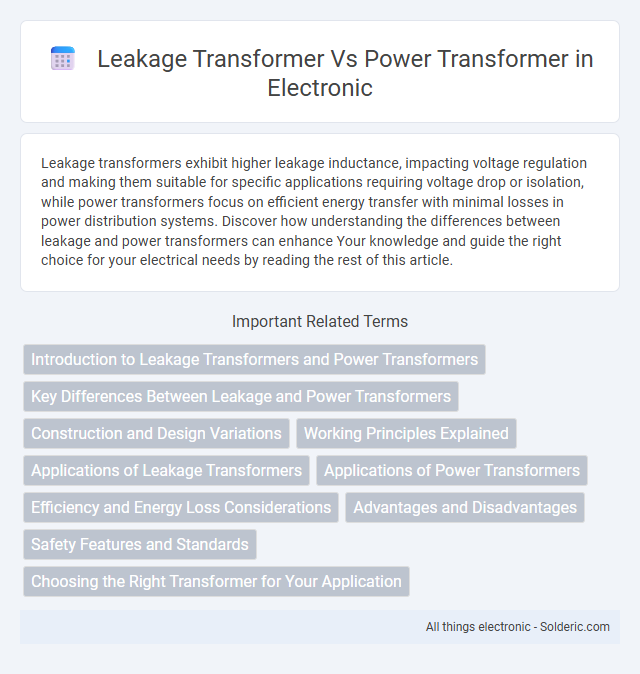Leakage transformers exhibit higher leakage inductance, impacting voltage regulation and making them suitable for specific applications requiring voltage drop or isolation, while power transformers focus on efficient energy transfer with minimal losses in power distribution systems. Discover how understanding the differences between leakage and power transformers can enhance Your knowledge and guide the right choice for your electrical needs by reading the rest of this article.
Comparison Table
| Feature | Leakage Transformer | Power Transformer |
|---|---|---|
| Primary Purpose | Limit short circuit currents and provide controlled leakage inductance | Transfer electrical energy efficiently between circuits at different voltage levels |
| Construction | Designed with increased leakage inductance by spacing windings apart | Designed for minimal leakage inductance with tightly coupled windings |
| Leakage Inductance | High leakage inductance | Low leakage inductance |
| Applications | Arc welding, current limiting, and industrial uses requiring impedance control | Power distribution, electrical grids, and general voltage transformation |
| Efficiency | Lower efficiency due to intentional leakage and losses | High efficiency for energy transfer |
| Output Voltage Regulation | Poor voltage regulation owing to leakage inductance | Good voltage regulation with minimal voltage drop |
| Core Type | Often shell or core type with designed spacing | Typically core type with optimized magnetic coupling |
Introduction to Leakage Transformers and Power Transformers
Leakage transformers are designed with intentional leakage reactance to limit short-circuit currents and provide voltage regulation in specialized applications, whereas power transformers are engineered to efficiently transfer electrical energy between circuits with minimal losses and are commonly used in power generation and distribution. Leakage transformers feature a higher leakage inductance by increasing the gap in the magnetic core, impacting voltage stability and current limiting properties. Power transformers exhibit low leakage inductance, optimized core materials, and high efficiency to ensure reliable voltage transformation over a wide range of loads.
Key Differences Between Leakage and Power Transformers
Leakage transformers primarily focus on limiting short-circuit currents through high leakage reactance, making them ideal for specialized applications like arc welding or current limiting. Power transformers are designed for efficient voltage transformation with low leakage reactance, ensuring minimal energy loss in power transmission systems. Your choice between these transformers depends on whether current limitation or efficient voltage regulation is the primary requirement.
Construction and Design Variations
Leakage transformers feature a design with increased magnetic flux leakage intentionally introduced by spacing or specific winding arrangements, allowing controlled impedance for applications like arc welding or induction heating. Power transformers are constructed with tightly coupled windings and a high-permeability core to minimize leakage inductance, optimizing efficiency for voltage transformation in electrical power grids. Your choice depends on whether you need controlled leakage for specialized functions or minimal loss for energy distribution.
Working Principles Explained
Leakage transformers operate by intentionally allowing a portion of the magnetic flux to leak between the primary and secondary coils, creating a controlled impedance useful for current limiting and voltage stabilization. Power transformers, on the other hand, are designed to maximize magnetic coupling between coils to efficiently transfer electrical energy with minimal losses. Understanding these working principles helps you choose the right transformer type for applications requiring either energy efficiency or controlled current flow.
Applications of Leakage Transformers
Leakage transformers are primarily used in applications requiring current limiting and voltage regulation, such as arc welding, induction heating, and neon sign transformers, where controlled leakage inductance helps stabilize the output. Unlike power transformers designed for efficient voltage conversion and power distribution, leakage transformers manage fault currents and provide safety by limiting short-circuit currents. Your choice of transformer depends on whether precise voltage transformation or protective current limitation is critical for your electrical system.
Applications of Power Transformers
Power transformers are essential in electrical grids for stepping voltage levels up or down, enabling efficient long-distance transmission and distribution of electrical power. They are predominantly used in substations and power plants to connect generation units with the transmission network or to supply end-user voltages. Their design optimizes energy conservation and minimizes losses, making them indispensable for large-scale power management and industrial applications.
Efficiency and Energy Loss Considerations
Leakage transformers typically exhibit lower efficiency than power transformers due to higher leakage reactance causing greater energy losses in the form of heat. Power transformers are designed with optimized core materials and winding techniques to minimize core loss and copper loss, resulting in superior energy efficiency during operation. You should consider these efficiency differences when selecting a transformer to reduce operational costs and energy waste in your application.
Advantages and Disadvantages
Leakage transformers provide improved voltage regulation and reduced short-circuit currents, making them advantageous for applications requiring current limiting and protection. Power transformers excel in efficiently transmitting electrical energy at high voltages with minimal losses and are essential for large-scale power distribution. Your choice depends on whether you prioritize current control and safety features or efficient high-power energy transfer.
Safety Features and Standards
Leakage transformers are designed with built-in electrical isolation and low voltage output to reduce the risk of electric shock, often complying with safety standards like IEC 61558 for safety isolating transformers. Power transformers incorporate robust insulation and protective devices adhering to standards such as IEEE C57 and IEC 60076 to prevent overvoltage, overheating, and short circuits. Both transformer types prioritize safety, but leakage transformers emphasize user protection in low-voltage applications, while power transformers focus on operational safety in high-voltage power distribution systems.
Choosing the Right Transformer for Your Application
Leakage transformers, designed with intentional leakage inductance, excel in applications requiring current limiting and voltage stabilization, whereas power transformers prioritize efficient voltage conversion and energy transfer across electrical systems. Your choice depends on whether you need controlled fault current and voltage regulation (leakage transformer) or reliable power distribution with minimal losses (power transformer). Understanding the specific load characteristics and operational requirements ensures optimal transformer selection for enhanced system performance and safety.
leakage transformer vs power transformer Infographic

 solderic.com
solderic.com